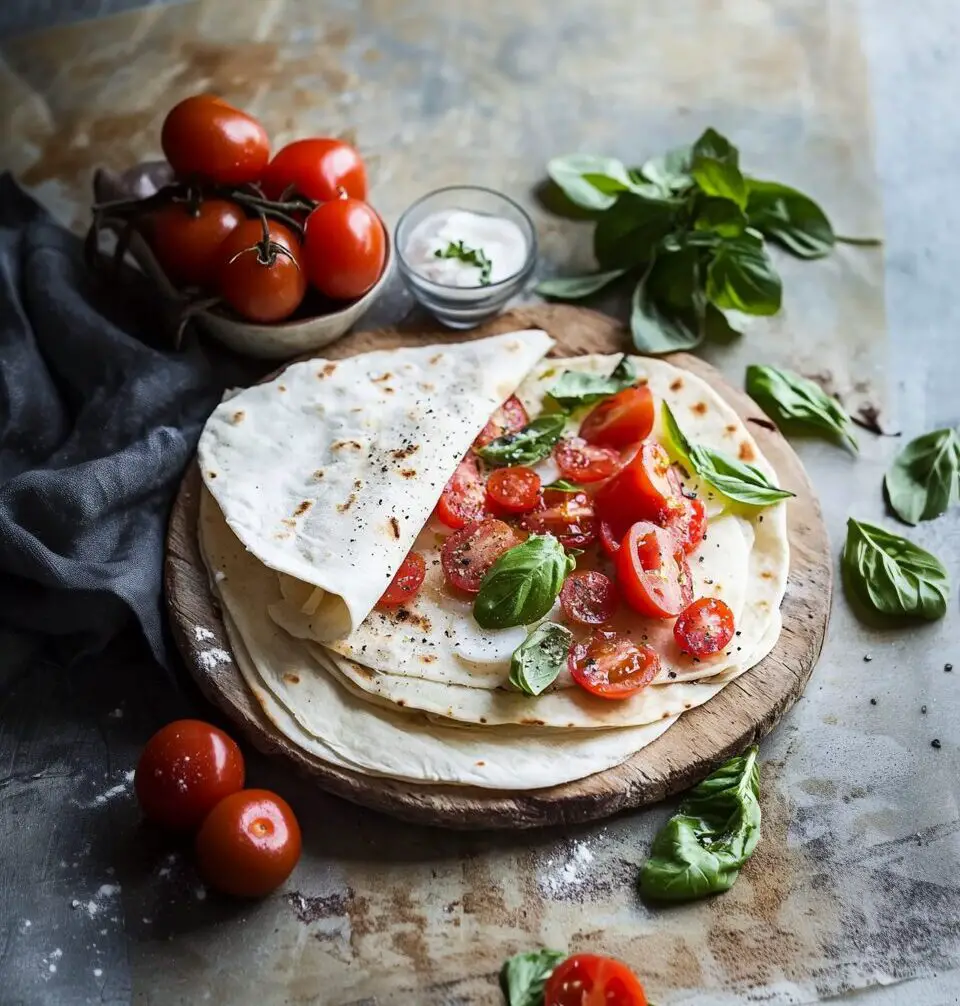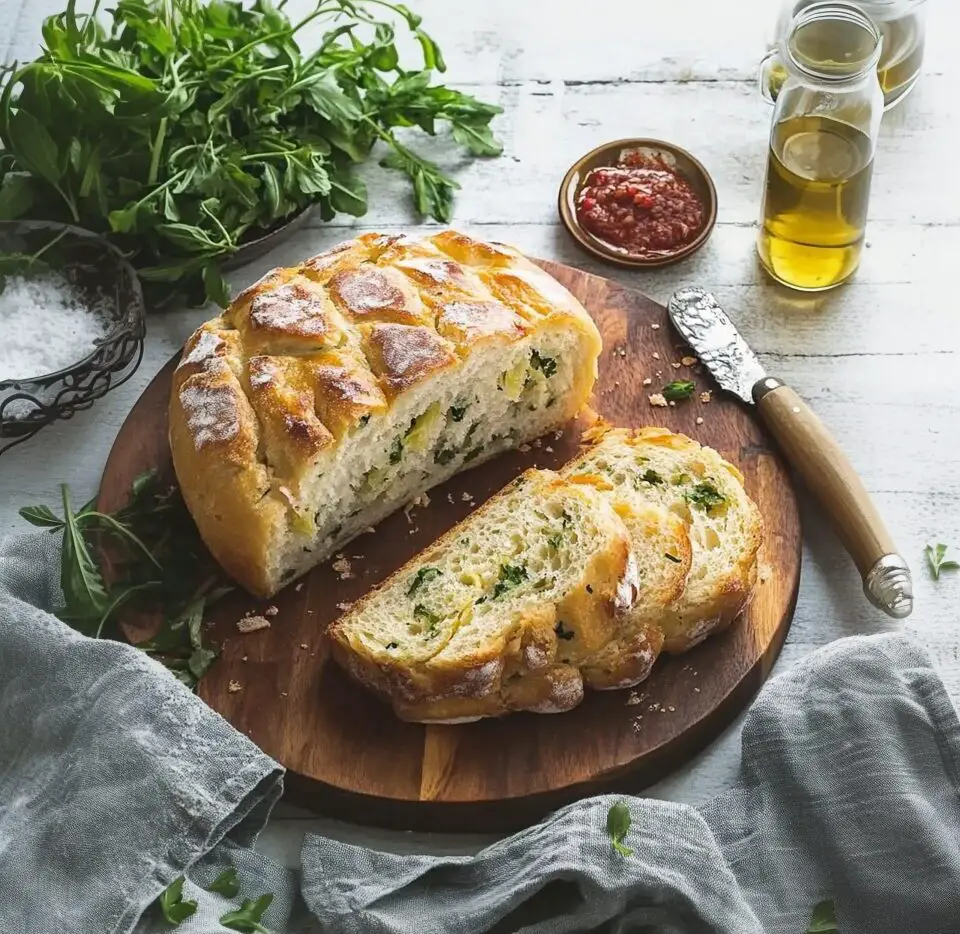La Piadina is a soft and fluffy Italian flatbread that can be filled with anything you like, from cured meats and cheese to grilled vegetables. Originating from the Emilia-Romagna region, this yeast-free bread is traditionally cooked on terracotta and has been a staple in Italian cuisine for generations. Its versatility makes it perfect for lunch, snacks, or picnics.
Full Recipe:
Ingredients
- 1.5 cups 00 flour or all-purpose flour (200g)
- ½ cup warm water (120ml)
- ½ tbsp olive oil
- 1 tsp baking powder
- ¼ tsp salt
Directions
- In a bowl, combine flour, baking powder, and salt.
- Make a well in the center and add warm water and olive oil. Mix to form a dough.
- Transfer the dough to a lightly floured surface and knead until smooth.
- Wrap the dough in plastic wrap and let it rest at room temperature for 30 minutes.
- Preheat a skillet over medium heat. Divide the dough into four equal parts and roll each into a thin round.
- Cook each flatbread in the skillet for about 2 minutes on each side, until puffed and golden.
- Fill each flatbread with your desired fillings and fold in half.
Nutritional Facts (Per Serving)
- Calories: 187 kcal
- Carbohydrates: 36g
- Protein: 5g
- Fat: 2g
- Saturated Fat: 1g
- Sodium: 270mg
- Potassium: 50mg
- Fiber: 1g
- Sugar: 1g
- Calcium: 75mg
- Iron: 2mg
The History and Cultural Significance of Piadina
Piadina has its roots in ancient Italy, with its history dating back to the times of the Roman Empire. Early versions of the flatbread were made by the ancient Italians using basic ingredients like flour, water, and salt. Over time, as the region developed and trade expanded, piadina evolved into the version we recognize today, incorporating olive oil, baking powder, and other elements to enhance the taste and texture.
In Emilia-Romagna, piadina was originally considered a peasant food, made quickly with basic ingredients and cooked on a terracotta or metal disk. The lack of yeast made it a practical choice for rural communities who needed a quick, easy source of sustenance. The flatbread was often served as a side dish to accompany soups or stews, and its simplicity was what made it so popular.
Over time, piadina became more than just a food; it became a symbol of regional pride. Today, it is still a central part of Emilia-Romagna’s culinary identity, and the recipe has been passed down through generations. The Piadina Festival, held annually in the town of Rimini, is a celebration of the bread and its cultural significance in the region. This festival brings together local chefs, food enthusiasts, and tourists to experience the diverse ways piadina is enjoyed.
How Piadina is Made: The Basics
Piadina is a simple bread, but there is a special technique involved in making it. The dough for piadina consists of just a few ingredients: flour, water, olive oil, baking powder, and salt. What makes piadina different from other flatbreads is the use of baking powder instead of yeast. This ingredient gives the bread its characteristic texture without the need for rising time.
Once the dough is mixed, it is divided into small portions and rolled out into thin rounds. These rounds are then cooked on a hot griddle or skillet, allowing the dough to puff up slightly and form a soft, chewy texture with crispy edges. Unlike pizza dough, piadina is typically not topped with sauce or cheese before cooking. Instead, it serves as a base for fillings that are added after it has been cooked.
Popular Fillings for Piadina
One of the most delightful aspects of piadina is its versatility. While it can be enjoyed as a simple flatbread on its own, piadina is often filled with a variety of ingredients to create a more substantial meal or snack. The classic Italian way to enjoy piadina is to fill it with cold cuts, cheeses, and vegetables, but there are endless possibilities to explore.
Traditional Fillings:
-
Prosciutto and Cheese: The most iconic filling for piadina is a combination of prosciutto di Parma (cured ham) and cheese, such as squacquerone or pecorino. This simple yet flavorful combination is the epitome of Italian culinary tradition. The salty prosciutto pairs perfectly with the creamy cheese, creating a balanced and delicious filling.
-
Rucola and Parmigiano: A more refreshing filling often includes arugula (rucola) and grated Parmigiano Reggiano. The peppery flavor of arugula contrasts beautifully with the sharpness of the cheese, creating a harmonious balance.
-
Grilled Vegetables: For a lighter, vegetarian version of piadina, grilled vegetables such as zucchini, eggplant, and peppers are often used. These vegetables provide a smoky, savory flavor that complements the soft texture of the bread.
Creative Variations:
In recent years, chefs have begun experimenting with piadina fillings, creating more modern takes on the traditional recipe. Some of these include:
-
Nutella and Strawberries: For a sweeter option, piadina can be filled with Nutella and fresh strawberries, making it a perfect dessert or snack. The rich chocolate-hazelnut spread pairs wonderfully with the sweetness of the strawberries, creating a decadent treat.
-
Chicken and Pesto: A delicious savory filling option is grilled chicken breast paired with pesto sauce and mozzarella. This variation adds a fresh, herby flavor to the piadina, making it a satisfying meal.
-
Egg and Bacon: For a breakfast-style piadina, scrambled eggs and crispy bacon are a great choice. Add some cheese for extra flavor and you have a delicious start to your day.
How to Serve Piadina
Piadina can be served in many ways, depending on the filling and the occasion. The most common way to enjoy piadina is as a lunch or snack, often served with a side salad or a cup of soup. Piadina can be cut into smaller pieces and served as an appetizer for a larger meal. It is also a great dish for picnics and outdoor gatherings, as it is easy to transport and doesn’t require utensils to eat.
Why Piadina is a Must-Try
Piadina is more than just a flatbread – it is a reflection of Italy’s rich culinary history and the creativity of its people. The simplicity of the dough, combined with the endless variety of fillings, makes piadina a versatile and delicious dish that can be adapted to suit any taste. Whether you prefer a classic prosciutto and cheese filling or a more adventurous combination like pesto and chicken, piadina offers a satisfying meal for any occasion.
Conclusion
Piadina is a quintessential Italian dish that has stood the test of time. Its humble origins, simplicity, and versatility make it a beloved food in Italy and beyond. Whether served as a light snack, a filling meal, or a dessert, piadina is a crowd-pleaser that can be enjoyed by anyone.








